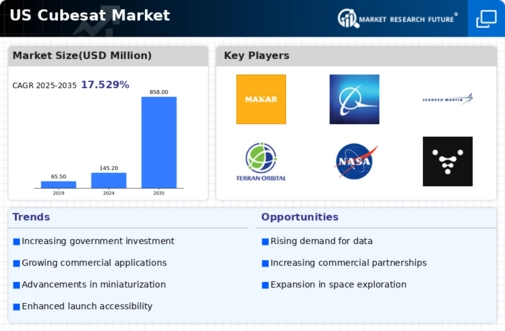Rising Commercial Investments
The cubesat market is experiencing a surge in commercial investments, driven by the increasing interest from private companies in space exploration and satellite technology. In recent years, venture capital funding for space startups has escalated, with investments reaching approximately $5 billion in 2024 alone. This influx of capital is enabling the development of innovative cubesat solutions, enhancing capabilities in areas such as telecommunications, remote sensing, and scientific research. As more companies enter the market, competition intensifies, leading to advancements in technology and reductions in costs. This trend is likely to continue, as the cubesat market becomes more attractive to investors seeking high returns in the burgeoning space economy.
Growing Demand for Data Analytics
The increasing demand for data analytics is driving the cubesat market, as organizations seek to leverage satellite data for various applications. Industries such as agriculture, urban planning, and climate monitoring are increasingly relying on data collected from cubesats to make informed decisions. In 2025, the market for satellite data analytics is projected to reach $3 billion, indicating a robust appetite for insights derived from satellite imagery. This trend is likely to propel the development of more sophisticated cubesat technologies, enabling higher resolution imaging and real-time data processing. As the need for actionable intelligence grows, the cubesat market is expected to expand, attracting new players and investment.
Government Initiatives and Funding
Government initiatives play a crucial role in the growth of the cubesat market, particularly in the United States. Agencies such as NASA and the Department of Defense have been actively promoting the use of cubesats for various applications, including national security and scientific research. In 2025, the federal budget allocated over $1 billion specifically for small satellite programs, reflecting the government's commitment to advancing this technology. These initiatives not only provide funding but also foster partnerships between government entities and private companies, facilitating innovation and development. As government support continues, the cubesat market is expected to expand, creating new opportunities for businesses and researchers alike.
Emerging International Collaborations
International collaborations are becoming a pivotal driver in the cubesat market, as countries recognize the benefits of shared resources and expertise in space exploration. Partnerships between nations, universities, and private companies are facilitating joint missions and research projects, enhancing the capabilities of cubesats. For instance, collaborative efforts in Earth observation and climate studies are gaining traction, with multiple countries contributing to the development and deployment of cubesats. This trend not only fosters innovation but also promotes the sharing of data and technology, which can lead to more effective solutions for global challenges. As these collaborations expand, the cubesat market is likely to see increased activity and investment.
Technological Advancements in Launch Services
The cubesat market is significantly influenced by advancements in launch services, which have become more accessible and cost-effective. The emergence of dedicated small satellite launch vehicles has reduced launch costs to as low as $5 million per mission, making it feasible for smaller organizations and universities to deploy cubesats. This democratization of access to space is likely to encourage a wider range of applications, from environmental monitoring to disaster response. As launch technology continues to evolve, the cubesat market is poised for growth, with an increasing number of satellites being deployed each year. The trend suggests that the barriers to entry for new players in the market are diminishing, fostering innovation and competition.
















